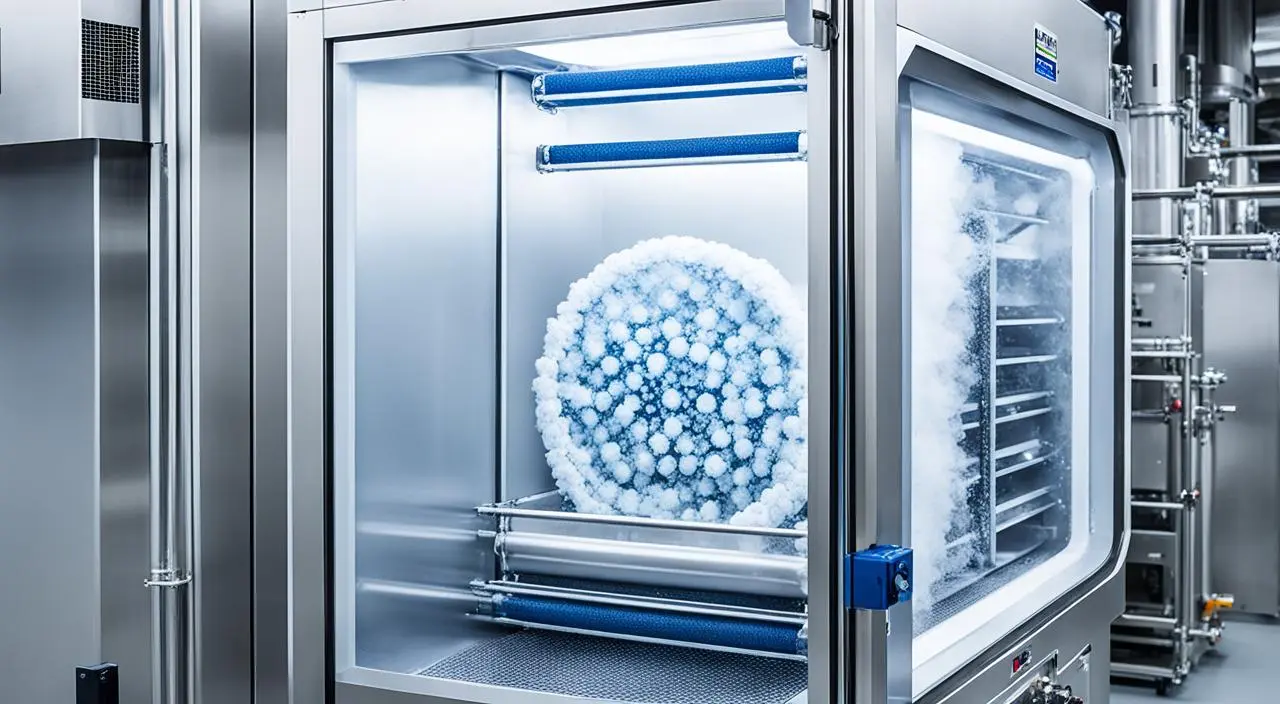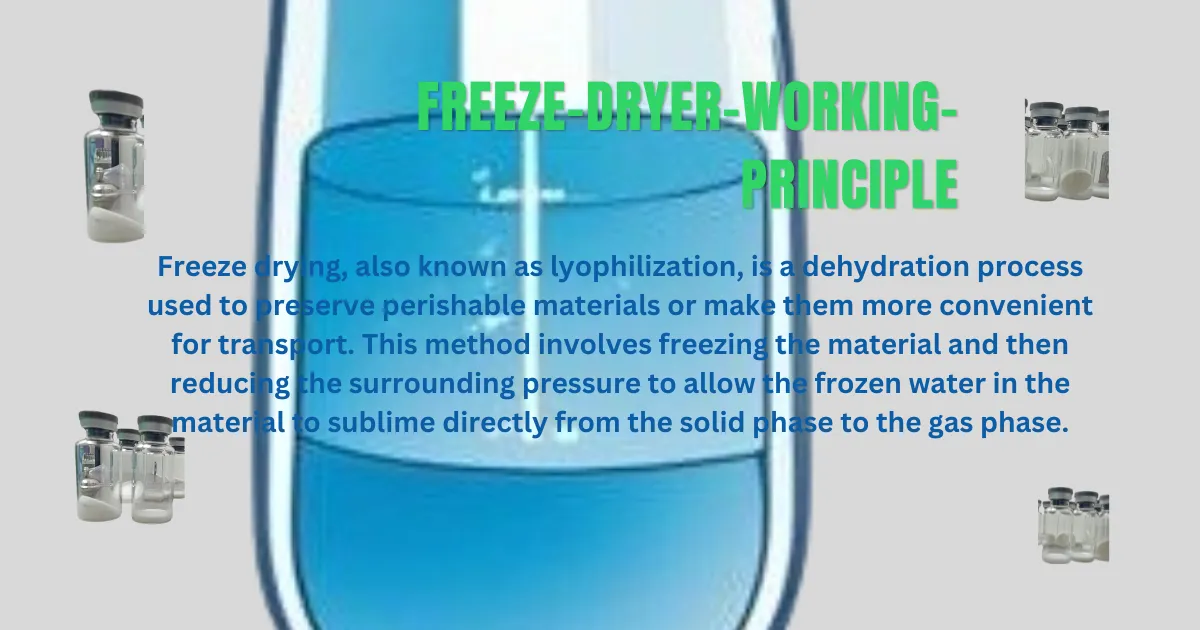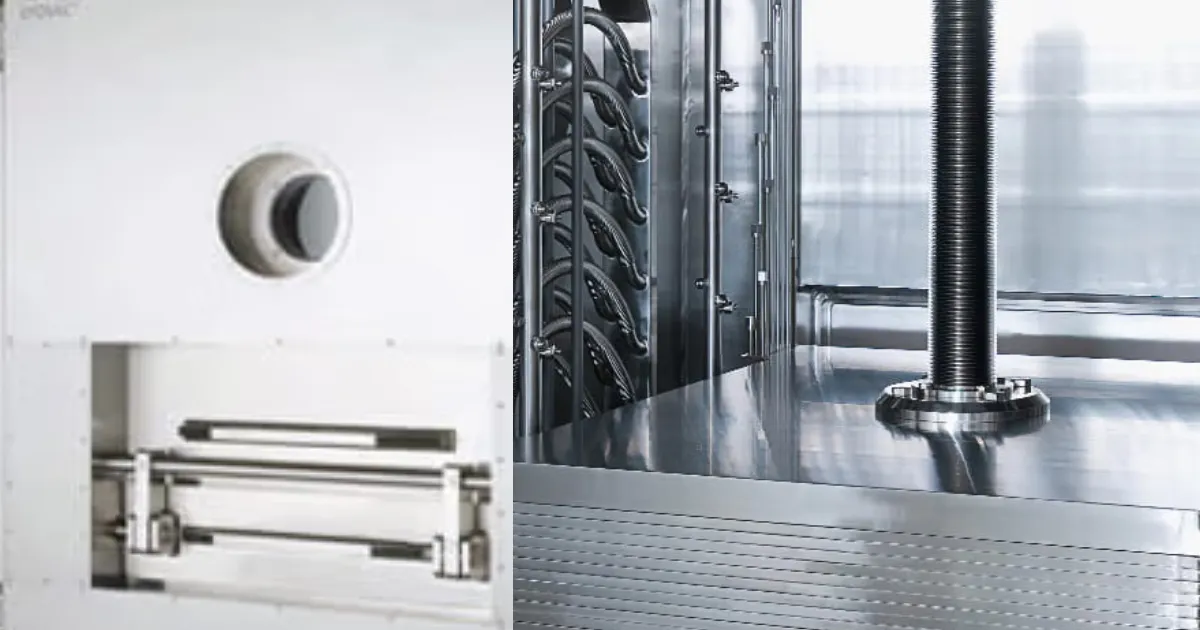Freeze-Dryer Working Principle, In the world of food preservation and pharmaceuticals, freeze drying has emerged as a crucial process, ensuring the longevity and quality of various products. But how does a freezer dryer work? Let’s delve into its working principles and explore its significance across different industries.
Key Takeaways
- Freeze-drying removes water through sublimation to preserve food.
- The process freezes the food, then removes ice through sublimation in a vacuum.
- Freeze-dried foods can last up to 25 years, making them great for long-term storage.
- This method keeps the food’s original taste, structure, and nutrients, unlike traditional drying.
- Freeze-drying is used in food, pharmaceuticals, and scientific research.
Introduction to Freeze Dryer
The Freeze Dryer Working Principle, also known as lyophilization, is a dehydration process used to preserve perishable materials or make them more convenient for transport. This method involves freezing the material and then reducing the surrounding pressure to allow the frozen water in the material to sublime directly from the solid phase to the gas phase.
Components of a Freeze Dryer
A typical freeze dryer consists of several key components, including a condenser, vacuum pump, and freeze-drying chamber. The condenser is responsible for collecting the evaporated moisture from the material being dried, while the vacuum pump maintains a low-pressure environment within the drying chamber.
Working Principles of Freeze Dryer or freeze dryer mechanism
Loading stage: After starting the freeze and reaching the loading temperature, open the freeze door on the aseptic side. Then, load the empty and filled vials into the freeze dryer and start the freezing cycle using the SCADA system.
Loading stage: Once the freeze dryer is started and the loading temperature is reached, the door is opened in a sterile area. Empty and filled vials are then loaded into the freeze dryer before initiating the freezing cycle using SCADA.
Freezing Stage (After loading, this phase starts)
In the first stage of the freeze-drying process, the material is frozen to solidify the water content. This freezing stage is crucial for preserving the structure and integrity of the material.

“The freeze-drying process is a highly efficient method of preserving the quality and nutritional value of foods, as the water is removed without subjecting the material to high temperatures, which can damage sensitive compounds.”
Primary drying (Sublimation Stage) (After freezing, the primary drying cycle starts)
Start this process after freezing Once frozen, the material is placed in the freeze-drying chamber, where the pressure is lowered. This reduction in pressure allows the frozen water in the material to transition directly from a solid to a gaseous state, bypassing the liquid phase. This process is known as sublimation.
Desorption Stage (Secondary Drying): after primary drying cycle ends, the secondary drying cycle starts
During the final stage, any remaining moisture is removed from the material through desorption. The condenser collects the evaporated moisture, leaving behind a dried product with minimal damage to its structure and properties.
Secondary Drying (Desorption): Remaining moisture is removed by further lowering pressure and raising temperature. or Water desorption from the cake starts in the same spot as primary freeze-drying is finished and all ice has been removed via sublimation. The primary drying phase begins when this stage, called secondary drying, begins.
Stoppering stage: After completing the secondary drying process, vials are fully stoppered in the freeze dryer using the stoppering force applied by the shelf.
Unloading stage: after completion of freeze drying and stoppering stage, reach the unloading temperature, open the door on aseptic area side and unload the freeze drying product. And send for capping of freeze-dried vials
Advantages of Freeze Drying
Freeze drying offers several advantages over conventional drying methods, including:
- Preservation of Nutritional Value: The low temperatures involved in freeze drying help retain the nutritional content of the material.
- Extended Shelf Life: Freeze-dried products have a significantly longer shelf life compared to fresh or conventionally dried products.
- Retention of Product Quality: The gentle drying process preserves the texture, flavor, and aroma of the material, resulting in a high-quality end product.
Applications of Freeze Drying
Freeze dryers are mainly used for food preservation. This method keeps foods fresh, saving their taste, texture, and nutrients. It’s great for keeping foods like fruits, veggies, and even cooked meals fresh for longer.

Freeze drying finds applications across various industries, including:
- Food Industry: Foods, including fruits, vegetables, and coffee, that have been freeze-dried are popular because of their extended shelf life and ease of use.
- Pharmaceutical Industry: Freeze drying is used to stabilize and preserve sensitive pharmaceutical products, including vaccines and antibiotics.
- Biotechnology: Freeze drying plays a crucial role in the preservation of biological samples and reagents used in research and diagnostic applications.
Factors Affecting Freeze-Drying Process
Several factors can influence the effectiveness of the freeze-drying process, including temperature, pressure, and the characteristics of the material being dried.
Comparison with Other Drying Methods
While freeze drying offers unique advantages, it’s essential to compare it with other drying methods such as air drying and spray drying to determine the most suitable approach for specific applications.
Common Challenges in Freeze Drying
Despite its numerous benefits, freeze drying also presents challenges, including the initial cost of equipment and ongoing maintenance requirements. Here are various alarm observed during freeze drying process
- Failure of all vacuum pump
- Failure of all vacuum pump during evacuation
- failure of the active MKS AND PIRANI chamber pressure sensor
- Failure of booth vacuum pressure sensor in the chamber
- loss of power during freeze-drying process
- failure of the temperature sensor in the shelf intake
- Failure of refrigerating compressor during condenser cooling
- failure of silicon heater
- Failure of the all-active silicon oil pump
Alarm observed during freeze drying process:
During the freeze-drying process, various alarms may be triggered to alert operators to potential issues. These alarms are critical for ensuring the safety and efficacy of the process, as well as the quality of the final product. The various alarms are given below
Failure of all vacuum pumps:
When all vacuum pumps fail, the freeze-drying process cannot maintain the necessary low-pressure environment required for sublimation. This failure can halt the entire process, leading to incomplete drying and the potential loss of the batch. Causes might include electrical issues, mechanical failure, or insufficient maintenance.
Failure of all vacuum pumps during evacuation:
If all vacuum pumps fail during the initial evacuation phase, the chamber cannot reach the required vacuum level. This prevents the freeze-drying cycle from starting properly and can compromise the entire process. Immediate troubleshooting and repair or replacement of the pumps are necessary.
Failure of the active MKS and Pirani chamber pressure sensors:
The MKS and Pirani sensors monitor the pressure within the chamber. If these sensors fail, accurate pressure readings cannot be obtained, leading to potential over- or under-drying of the product. This failure can be caused by sensor malfunction, calibration issues, or wiring problems.
Failure of both vacuum pressure sensors in the chamber:
The failure of both vacuum pressure sensors means the system cannot verify or control the pressure accurately, which is critical for the freeze-drying process. This can lead to process inefficiency and product quality issues. Redundancy in sensors and regular maintenance can help prevent such failures.
Loss of power during the freeze-drying process:
A power loss can disrupt the entire freeze-drying process, causing temperature and pressure fluctuations that can damage the product. Backup power systems, such as uninterruptible power supplies (UPS) and generators, are essential to mitigate this risk and ensure continuous operation.
Failure of the temperature sensor in the shelf intake:
The temperature sensor in the shelf intake monitors the temperature of the shelves that hold the product. If this sensor fails, the system cannot accurately control the shelf temperature, leading to improper freezing or drying conditions. Regular calibration and maintenance of temperature sensors are crucial.
Failure of the refrigeration compressor during condenser cooling:
The refrigerating compressor is responsible for cooling the condenser, which is essential for removing water vapor from the chamber. If the compressor fails, the condenser cannot effectively capture and condense water vapor, leading to incomplete drying. This can result in product spoilage and require immediate repair or replacement.
Failure of the silicon heater:
The silicon heater is used to control the temperature of the shelves during the drying process. If the silicon heater fails, the shelves cannot be heated correctly, disrupting the sublimation process and leading to uneven or insufficient drying. Regular inspections and preventive maintenance can help avoid such failures.
Failure of all active silicon oil pumps:
Silicon oil pumps circulate thermal fluid to maintain a uniform temperature across the shelves. If all active pumps fail, temperature control becomes inconsistent, affecting the drying process and potentially compromising product quality. Ensuring redundancy and routine maintenance of the pumps can prevent such failures.
Understanding and addressing these potential failures is vital for maintaining the integrity of the freeze-drying process and ensuring the production of high-quality lyophilized products. Regular maintenance, calibration, and having contingency plans in place can significantly reduce the risk of these issues.
Conclusion of Freeze-Dryer Working Principle
In conclusion, the working principle of a freeze dryer revolves around the controlled removal of moisture from materials through freezing, sublimation, and desorption. This process offers unparalleled preservation of nutritional value, extended shelf life, and retention of product quality, making it indispensable across various industries.
FAQs
How does freeze drying differ from other drying methods?
Freeze drying involves the sublimation of frozen water from the material, resulting in superior preservation of texture and nutrients compared to conventional drying methods.
What types of products are commonly freeze-dried?
Foods such as fruits, vegetables, and meat, as well as pharmaceuticals and biological samples, are commonly subjected to freezing.
Can freeze-drying be done at home?
While it’s possible to purchase small-scale freeze dryers for home use, they are typically expensive and may require specialized knowledge to operate effectively.
What are some key considerations for selecting a freezer dryer?
Factors to consider include the size of the drying chamber, the capacity of the condenser, and the level of automation required for the intended application.
Is freeze-drying environmentally friendly?
While freeze drying consumes energy, its ability to preserve products for an extended period can help reduce food waste, making it a more sustainable option in certain contexts.

